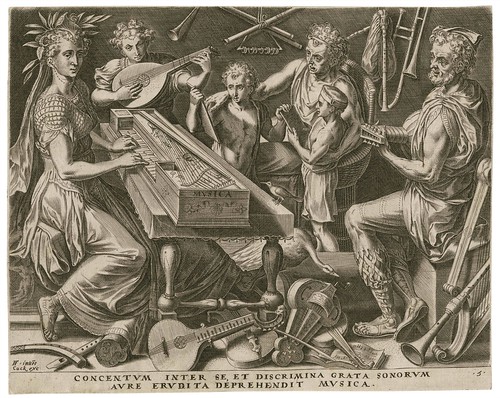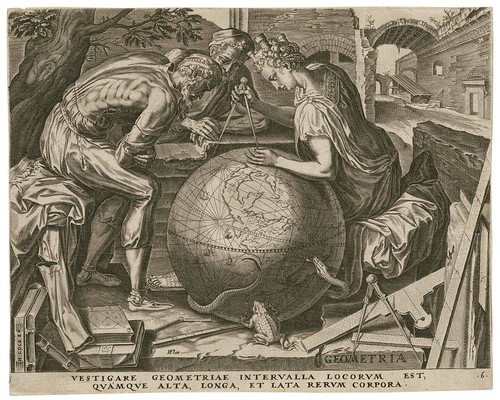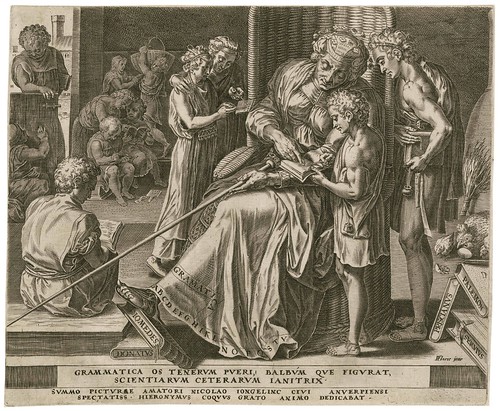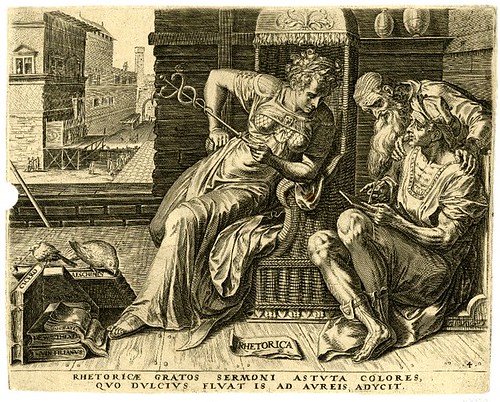"The areas of secular education considered liberal have their foundation in classical antiquity and were codified in the medieval period into a distinct set of seven, with two subdivisions. The upper division, the quadrivium, consists of Geometry, Arithmetic, Astronomy, and Music; while the lower division, or trivium, is made up of Grammar, Logic (or Dialectic), and Rhetoric. [..]
The tradition of artistic representation of the Seven Liberal Arts may be traced to the fifth-century work of Martianus Capella*; his allegorial treatise, 'De Nuptiis Philologiae et Mercurii Libri Novem' ['Satyricon'], describes the Seven Liberal Arts as personified female figures with specific attributes and companions." [source]

Musica
Concentum inter se, et discrimina grata
sonorum aure erudita deprehendit musica
sonorum aure erudita deprehendit musica
Music, a woman, sits at a harpsichord; another female plays a lute and two youths embraced by an elder sing and hold tablets; a man sits at right and plays on a lute and the ground is strewn with instruments; more instruments hang from the wall, including a bagpipe and trombone.

Geometria
Vestigare geometriae intervalla locorvm est,
qvamqve alto, longa, et lata rervm corpora
qvamqve alto, longa, et lata rervm corpora
Geometry, a woman, uses compasses to measure the globe watched closely by two male figures; various measuring devices are in the foreground together with academic tomes.

Arithmetica
Haec contemplandis numeris ars gaudet,
eorum occulta sollers ervens mysteria
eorum occulta sollers ervens mysteria
Arithmetic, a woman, seated at a table inscribes a tablet accompanied by an elderly woman and two male scholars; the elderly woman stands over her and instructs her; her dress is numbered "1234..." and two tomes are labelled "ABRAHAM" and "PYTHAGORAS".

Astrologia
Astrorvm Vraniae cvrsvs, variosqve recvrsvs ocvlis
notans fvtvra mente praevidet; Astrorum Uraniae cursus
notans fvtvra mente praevidet; Astrorum Uraniae cursus
Astrology, a winged female personification, leans besides a globe with zodiacal star symbols; on the ground are various scientific instruments and sundials etc; an eagle spreads its wings and stands besides a pile of books labelled "ANAXIMENES" etc.

Dialectica
Vti hominem ratione docet dialectica quare
merito artium apicem magnus hanc plato vocat
merito artium apicem magnus hanc plato vocat
Dialectic, a woman, seated on a wicker chair, engages in conversation with an elderly philosopher; she rests her feet on a stack of tomes labelled "ARISTOTELES" etc; a bird sits on her head, an eel is wrapped around her arm and a frog sits on an upright tome.

Grammatica
Grammatica os tenerum pueri, balbum que
figurat, scientiarum ceterarum ianitrix
figurat, scientiarum ceterarum ianitrix
Grammar, a seated old woman, teaches a young boy standing besides her the rudiments of reading and writing; she holds a long staff, leans over and points to the pages of the book held by the youth; her dress has the letters of the alphabet; in a school room with students and various labelled scholarly tomes.

Rhetorica
Rhetoricae gratos sermoni astvta colores
qvo dvlcivs flvat is ad avreis advcit
qvo dvlcivs flvat is ad avreis advcit
Rhetoric, a seated woman, holding a caduceus, leans over and engages with a seated man writing on a tablet; an elderly man with a long beard places his hands on the shoulder of the younger scholar; two birds, including a parrot, sit on a pile of books labelled "CICERO" etc on the ground.
The allegorical mannerist images above were engraved by Cornelis Cort (after Frans Floris) and published in Antwerp in 1565 by Hieronymous Cock.
"One of the most famed printmakers of his day, Cornelis Cort was admired for his ability to translate tonal qualities into a black and white engraving. Cort accomplished this in part through an important technical innovation: It is the nature of an engraved line, cut as it is with a tool (the burin) whose cutting edge comes to a sharp triangular point, to begin as a point, swell almost imperceptibly at the center, and narrow to a point again at the end. Cort exploited this quality of the burin line; by varying his pressure on the tool as he gouged the plate, he developed a flexible line that becomes thicker and thinner along its length, creating various degrees of darkness without adding additional lines."
The first six plates above come from the Folger Shakespeare Library Image Collection [homepage]; the last picture (and most of the notes) is from the BM.
See: The Seven Liberal Arts at New Advent.
-----------------------------------------------------
About a year ago I was talking with my teenage niece and I asked her if there had ever been any instruction in web searching as part of her regular school work (there hadn't been). My niece and her mother both expressed surprise when I suggested that the art of searching involved more than just pointing a browser to google.com. Considering the amount of time and energy we devote to searching for information online, it's logical to assume that life would improve (yes, marginally!) if we were all better versed in the tricks and skills associated with formulating useful search queries.
I'm no expert on search and only wish I remembered and used more than a handful of the advanced techniques from the various cheat sheets around the traps. Web search is usually pretty easy most of the time of course, particularly nowadays, with all the options available to modify the queries. In terms of school I had more in mind the idea of learning the strategies and paths one might take - beyond advanced operators - for complex searches, like when it's better to hit specific types of databases or when you should give up and email somebody, for instance. It's this development of lateral thinking that I would have thought merited a bit more than hit-or-miss / trial-and-error approaches in school classrooms.
If web search is itself an occasionally complicated procedure, it usually pales by comparison to the elaborate tasks involved, more often than not, in image searches; depending on the target picture desired. One of the main difficulties comes from the translation of a text query into a visual result. Sure, that's stating the bleeding obvious, but the problem is that the desired image might not have the words "red hat" or "dubois" or "15th century engraving", or whatever your search term is, in the alt or title tags or as text on the webpage near the target. So searching with the usual text terms can be fruitless or at least less successful.
Now I love google images and use it all the time - I use it as much as a conduit to discover background information in fact - but it's only ever partially useful: a good place to start in the same way as wikipedia can be a good place to start when looking for textual background and links. We now also have the emerging dimension of similarity based image search which I haven't used a lot, but it's another weapon in the arsenal.
I see image search (much like web search in a way) as a problem solving exercise: some people like doing crosswords, I like hunting down visual materia obscura. I don't think it would be particularly useful to outline the steps I take to solve a specific query - they are all individual and the steps I might take will differ accordingly - but I thought it might be useful to some people if I post all the sites I have in a drop-down 'art' folder in my browser. If you are reading via a feedreader, there are a whole bunch of links under 'resource sites' in the sidebar of BibliOdyssey - that include some of these listed below - but they tend more towards the library and exhibition types. The links in the browser folder are where I actually go to find stuff when I'm looking to fill out a post with more images than are contained in a single book or from a single web exhibition site, for example. They are necessarily skewed towards the prints and graphics but many of them are generalist art sites and useful beyond my obsessional parameters.
This list is in order of value (to me!). That value is basically a function of how productive of images they are combined with how much I like the site. Science and Society is at the bottom of the list because the bastards watermark copyright-free material; but they are a very useful resource nevertheless because of the very thorough list of linked image descriptors - "hat", "girl", "engraving", etc etc - and they often have unique background information. I think all but one of these links goes directly to a page with a search box (the Lyons site is timer based so you have to click through to commence a session). So I hope these prove useful to someone...
[Incidentally, this post comes via an entry on the WorldCat blog announcing the inclusion of a large record collection (including images) from an enormous consortium of libraries and museums, into the WorldCat database. It's perhaps a little clunky, but it's this sort of consolidation - like the collection search links for the Smithsonian and the V&A below - that makes tracking down obscure material that much easier.]
British Museum Prints Database
New York Public Library Digital Gallery
Fine Arts Museum of San Francisco
La base Estampes de la Bibliothèque municipale de Lyon
Rijksmuseum
Smithsonian Institution - Collections Search Center *NEW*
Metropolitan Museum of Art
Victoria & Albert - Search the Collections *NEW*
Culture.fr: le portail de la Culture
Graphische Sammlung Stift Göttweig (Austria)
Ornamental Prints Online (Berlin, Prague, Vienna)
Banque d'Images - Centre de Recherche: Chateau de Versailles
Los Angeles County Museum of Art
The National Gallery of Art
Virtuelles Kupferstichkabinett
Inventaire du Département des Arts Graphiques (Musée du Louvre)
Museum of Fine Arts, Boston
The Cleveland Museum of Art
Minneapolis Institute of Arts
The Detroit Institute of Arts
The State Hermitage Museum (St. Petersburg)
Zeno Image Database (German)
Collage: Guildhall Print Room & Art Gallery
Science & Society Picture Library
Later: I should add that I don't necessarily use these sites, per se, to find a desired image. Often times they merely provide clues: alternative names, associated book and print titles, dating evidence, more examples by the artist or genre in question and sometimes lack of results can hint whether or not further exploration is likely to be of value. And obviously this list is just the beginning. The information gleaned in one or more of these sites may just lead back to google image search and/or on to more specialised portals and the like.
-------------------------------------------------------




No comments:
Post a Comment